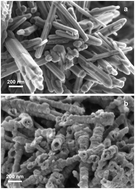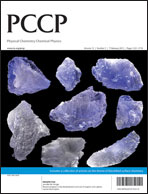New insight into the ZnO sulfidation reaction: mechanism and kinetics modeling of the ZnS outward growth†
Abstract
Zinc oxide based materials are commonly used for the final desulfurization of synthesis gas in Fischer–Tropsch based XTL processes. Although the ZnO sulfidation reaction has been widely studied, little is known about the transformation at the crystal scale, its detailed mechanism and kinetics. A model ZnO material with well-determined characteristics (particle size and shape) has been synthesized to perform this study. Characterizations of sulfided samples (using XRD, TEM and electron diffraction) have shown the formation of oriented polycrystalline ZnS nanoparticles with a predominant hexagonal form (wurtzite phase). TEM observations also have evidenced an outward development of the ZnS phase, showing zinc and oxygen diffusion from the ZnO–ZnS internal interface to the surface of the ZnS particle. The kinetics of ZnO sulfidation by H2S has been investigated using isothermal and isobaric thermogravimetry. Kinetic tests have been performed that show that nucleation of ZnS is instantaneous compared to the growth process. A reaction mechanism composed of eight elementary steps has been proposed to account for these results, and various possible rate laws have been determined upon approximation of the rate-determining step. Thermogravimetry experiments performed in a wide range of H2S and H2O partial pressures have shown that the ZnO sulfidation reaction rate has a nonlinear variation with H2S partial pressure at the same time no significant influence of water vapor on reaction kinetics has been observed. From these observations, a mixed kinetics of external interface reaction with water desorption and oxygen diffusion has been determined to control the reaction kinetics and the proposed mechanism has been validated. However, the formation of voids at the ZnO–ZnS internal interface, characterized by TEM and electron tomography, strongly slows down the reaction rate. Therefore, the impact of the decreasing ZnO–ZnS internal interface on reaction kinetics has been taken into account in the reaction rate expression. In this way the void formation at the interface has been modeled considering a random nucleation followed by an isotropic growth of cavities. Very good agreement has been observed between both experimental and calculated rates after taking into account the decrease in the ZnO–ZnS internal interface.


 Please wait while we load your content...
Please wait while we load your content...